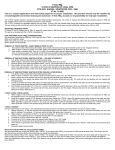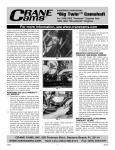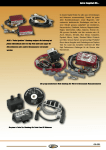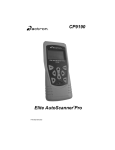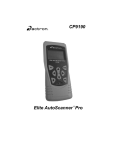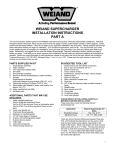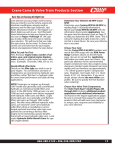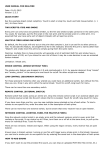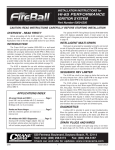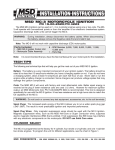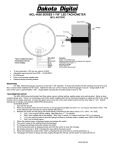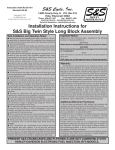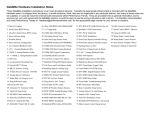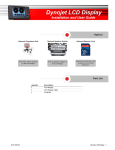Download HI-4N MOTORCYCLE IGNITION
Transcript
Installation Instructions for HI-4N MOTORCYCLE IGNITION For more information, see www.cranecams.com CAUTION: READ INSTRUCTIONS CAREFULLY BEFORE STARTING INSTALLATION. 2.Refer to Figure 1. Remove ignition cover plate, gasket, and INTRODUCTION hardware (items 1-3). Save these items for later re-use. The HI-4N ignition system is intended for use with Harley-Davidson® motorcycles. The HI-4N replaces the original equipment (OE) electronic ignition system on 1978 and later models as well as the points and mechanical advance on early models. Will not work in 2000–2003 Sportster®. 3.Note location of breaker plate. There is a V notch in the breaker plate used for alignment. When you install the HI-4N, align the V notch in the same location. This should set the timing close enough to start the engine. Remove and save the two standoffs and washers (items 4-5). Remove the breaker plate assembly, wiring, cam, and advance assembly (items 6–10). WARNING: 1996 and later models have a vehicle tilt sensor that shuts off the ignition if the motorcycle rolls on its side. This feature is disabled when the HI-4N ignition is installed. REMOVAL OF OE ELECTRONIC IGNITION SYSTEM—1978 AND 1979 MODELS The HI-4N features state-of-the-art technology that allows adjustable advance and rev limit. A timing LED indicates static timing (top dead center) and gives diagnostic information. Two starting modes are provided: electric start and kick start. A tach output gives accurate tach readings even at the rev limit. 1.Turn ignition switch off and disconnect battery ground cable. 2.Refer to Figure 2. Disconnect wires going from ignition module (item 3) to coil (14). 3.Remove ignition cover plate and hardware (items 1 and 2). Save these items for later re-use. Remove ignition module (3). ADDITIONAL REQUIRED PARTS FX series Big Twin® and XL series Sportster® models prior to 1984, FL series Big Twin® models prior to 1985, and all models with OE points will require OE timing rotor P/N 32402-83. This part is not included with the HI-4N installation kit and can be purchased separately, Crane Cams Part Number 8-1150. 4.Note location of timer plate (10). There is a V notch in the timer plate used for alignment. When you install the HI-4N, align the V notch in the same location. This should set the timing close enough to start the engine. Remove and save the two standoffs and washers (items 4-5). Remove the sensor, shield, timer plate, trigger rotor, and advance assembly (items 6-12). COIL AND SPARK PLUG CABLE CONSIDERATIONS REMOVAL OF OE ELECTRONIC IGNITION SYSTEM—1980 AND LATER MODELS We recommend replacing the OE coil. Coils used with the HI-4N must have at least 2 ohms primary resistance. Coils with 4 ohms or higher may be used, but may not produce optimum output. We recommend the following coils for single and dual-plug applications: 1.Turn ignition switch off and disconnect battery ground cable. 2.Refer to Figure 3. Remove OE ignition module and wire harness (items 1-4). You will disconnect two wires at the coil, wire going to the VOES (Vacuum Operated Electrical Switch), ground wire at the module, and the 3 pin plug (20) that connects to the sensor plate. Refer to shop manual for locations. HI-4N Ignition With Single Plug Heads. Use Crane Cams P/N 8-3005 coil, which will fit in the stock mounting location on most H-D® motorcycles. You can also use two dual spark tower coils and ground one of the towers on each coil to the engine case or frame. You will have to fabricate a bracket to mount the second coil. 3.Remove ignition cover plates and gasket (items 5- 9). This will require drilling out two rivets. The rivets will later be replaced with two supplied self threading screws. HI-4N Ignition With Dual Plug Heads. Use two Crane 8-3006 coils. You will have to fabricate a bracket to mount the second coil. 4.In order to remove the sensor plate cable, the cable plug (20) must be removed first. Use needle nose pliers to pull the terminals out of the plug. Then pull the cable through the exit hole at the bottom of the timing cover. Crane FireWire spiral core wires are recommended for maximum performance. Do not use solid copper spark plug cables; they may cause interference with your ignition system and accessories. 5.Note location of sensor plate (11). There is a V notch in the sensor plate used for alignment. When you install the HI-4N, you should align the V notch in the same location. This should set the timing close enough to start the engine. Remove and save the two standoffs and washers (10). Remove the sensor plate (item 11). REMOVAL OF POINTS IGNITION — EARLY MODELS PRIOR TO 1978 1.Turn ignition switch off and disconnect battery ground cable. Disconnect wire going from breaker points to Coil– (negative) terminal. Daytona Beach, FL 32117 | www.cranecams.com | Phone: 866-388-5120 | Fax: 386-236-9983 6/12 1 9000-6100 Figure 1. Harley-Davidson® OE Points System 11 10 8 9 6 7 5 4 3 2 1 1. Circuit Breaker Cover Screws (2) 2. Circuit Breaker Cover 3. Circuit Breaker Cover Gasket 7. Circuit Breaker Cam Bolt 8. Breaker Plate Assembly 9. Breaker Cam 10. Advance Assembly 4. Breaker Plate Screws (2) 5. Breaker Plate Screw Lockwashers & Washers (2 each) 6. Retainer (1971 to early 1972) 11. Gear Case Cover Figure 2. Harley-Davidson® 1978-79 OE Electronic System 17 1. Cover Screws (2) 10. Timer Plate 2. Ignition Timer Cover 11. Trigger Rotor 3. Ignition Module 4. Timer Plate Screws (2) 12. Advance Assembly 13. Gear Case Cover 5. Washers (2) 6. Screws & Washers (2 each) 14. Ignition Coil 15. Spark Plug Wires (2) 7. Shield 8. Sensor 16. Ignition Coil Terminal (FX) 17. Ignition Coil Terminal (FL) 16 15 9. Trigger Rotor Bolt 13 14 12 11 10 9 8 7 6 5 4 3 HI-4N INSTALLATION 1 NOTE: Damage will result if the brown tach wire comes in contact with +12V. Refer to Figure 4. The HI-4N requires OE timing rotor P/N 32402-83, or Crane Cams Part Number 8-1150. Check your rotor (9) for correct part number. For models prior to 1980, use the supplied 10-32 x 3/4” bolt and washer to mount the rotor. 1.Identify switched +12 volt wire and tach wire (if equipped) going to the coil. Refer to your service manual, or reconnect the battery and use a test light or voltmeter. The switched +12 volt wire will be hot when the ignition key is turned on. 1.Install HI-4N system in place of OE breaker or sensor plate. Rotate the HI-4N about 90 degrees to give better access to the cable exit hole in the gear case cover. On some early models it may be necessary to enlarge this hole. Install the HI-4N first, then push the cable through the hole. Align the V notch on the HI-4N same as the OE plate you removed. Use the OE standoffs to secure the HI-4N. You must use lock washers under the standoffs for proper clearance between the HI-4N and cover plate. Do not fully tighten the standoffs until the timing has been set. 2.Refer to Figure 5, 6, or 11 depending on your application. Connect the HI-4N white wire and switched +12 volt wire to Coil + (positive). 3.Connect the HI-4N pink wire to the Coil – terminal on the coil for the front cylinder. 4.Connect the HI-4N blue wire to the Coil – terminal on the coil for the rear cylinder. 5.Connect the HI-4N violet wire to the vacuum switch (Figure 3, item 18), if used. 2.Route the HI-4N harness along the frame rails to the coil. Make sure that harness will not be chafed or burned by exhaust heat. Secure harness with tie wraps. Do not install timing cover. 6.Connect the HI-4N brown wire to the tach wire, if equipped with a tachometer. Tape up if unused. HI-4N HOOKUP 7.The HI-4N is grounded via the timing housing; a separate ground connection is not required. Crimp terminals and hardware are supplied for your convenience. Use the ring terminals for coil hookup. Use male-female quick disconnects for connections to the tach and vacuum switch (VOES). Tape up unused wires. 6/12 2 8.Reconnect battery ground cable. Verify proper ground connections to the frame and engine. 2 9000-6100 Figure 3. Harley-Davidson® 1980 and Later OE Electronic System 1. Screws (2) 13. Rotor 17. Spark Plug Wires (2) 2. Washers (2) 14. Gear Case Cover 18. Vacuum Operated Electrical Switch (VOES) 15. Ignition Coil 19. VOES Connector 16. Ignition Coil Terminal 20. Sensor Connector 3. Ignition Module 4. Well Nuts (2) 5. Rivets (2) 6. Outer Cover 7. Inner Cover Screws (2) 18 8. Inner Cover 9. Gasket 10. Sensor Plate Screws & Washers (2 each) 11. Sensor Plate 17 16 19 15 12. Rotor Screw & Star Washer 14 13 20 11 12 9 8 10 7 6 5 4 3 2 1 Figure 4. HI-4N Ignition System Installation 10 9 1. 2. 3. 4. 7 Buttonhead Screws (2) Outer Cover Inner Cover Screws (2) Inner Cover 8 6 SPKADV X MA MIN -5 0 RACEONLY HI-4N Unit 6/12 5 5. Gasket 6. Sensor Plate Screws & Washers (2 each) 7. HI-4N Unit 8. Rotor Screw & Star Washer 9. Rotor 10. Gear Case Cover 4 2 3 1 TS ALLOEPOIN ELECSTART Use Supplied Gasket 3 9000-6100 MODELS WITHOUT OE VACUUM SWITCH (VOES) NOTE: Most motorcycle coils do not have terminals marked. Most singlefire coils use the center terminal for +12V and the outer two terminals for front and rear cylinder Coil–. For dualfire coils use either terminal for Coil+ and the other one for Coil–. This includes most models prior to 1985. Fuel economy and driveability will be improved if you install a VOES and connect it to the HI-4N violet wire as shown in Figures 5, 6, and 11. We recommend you use H-D® VOES P/N 26566-91. If the VOES is not used, tape up the violet wire. VOES HOOKUP The OE vacuum switch (VOES) is normally an open circuit. Above 3-5 inch-Hg vacuum, the VOES closes and grounds the vacuum input on the OE module. This increases the total advance generated by the OE ignition module. Vacuum advance improves part throttle driveability and fuel economy. Connect the VOES to the HI-4N violet wire as shown in Figures 5, 6, and 11. HI-4N SETUP AND OPERATION Refer to the cover plate on the HI-4N, and the switch table on page 6. The unit has four switches that select the operating modes, advance rate, and rev limit. The top switch sets the operating mode. Use the OEM with VOES advance curve for stock and modified engines with OE electronic or points ignition. Use the Race Only advance curve for high compression engines. Kick start mode fires the first cylinder for quick starting. Electric start mode delays firing for 2 revolutions of the crankshaft for smoother starts and less strain on the starter. NOTE: 1996 and later models use a 2 wire connector between the VOES and the OE harness. Connect one wire from the VOES switch to frame ground and connect the other wire to the VOES input (violet wire) on the HI-4N. The advance curve is adjustable over a limited range via the advance rate switch (SPK ADV). Advance curves are given in Figure 5. HI-4N Single Fire System Hookup with Single Plug Heads ALTERNATE HOOKUP USING TWO DUAL TOWER COILS TO IGNITION SWITCH IGNITION SWITCH FRONT SPARK PLUG O.E. WHITE WIRE TO COIL + IGNITION COIL +12V FRONT COIL + – HI-4N WHITE WIRE GROUND HI-4N PINK WIRE 12 VOLT BATTERY IGNITION COIL REAR SPARK PLUG REAR COIL HI-4N BLUE WIRE MODE SWITCH MUST BE SET TO 0, 1, 2, 3, OR 8 FOR SINGLE FIRE APPLICATIONS FRONT SPARK PLUG REAR SPARK PLUG HI-4N MODE ADVANCE RATE CRANE 8-3005 SINGLE FIRE COIL X1000 RPM LIMIT X100 BLUE HI-4N IGNITION PINK WHITE 8-6100 BROWN RPMX100 VIOLET NOTE: If TACH or VOES are not used, tape up the corresponding wire. 6/12 4 VOES (VACUUM SWITCH) 9000-6100 Figure 6. HI-4 Single Fire System Hookup with Dual Plug Heads IGNITION SWITCH O.E. WHITE WIRE TO COIL + +12V + – CRANE 8-3006 OR SIMILAR DUAL TOWER COILS SHOWN IGNITION COIL FRONT COIL AND SPARK PLUGS IGNITION COIL REAR COIL AND SPARK PLUGS 12 VOLT BATTERY GROUND PINK WHITE MODE SWITCH MUST BE SET TO 0, 1, 2, 3, OR 8 FOR SINGLE FIRE APPLICATIONS HI-4N MODE BLUE ADVANCE RATE X1000 RPM LIMIT X100 8-6100 BROWN HI-4N IGNITION RPMX100 VIOLET NOTE: If TACH or VOES are not used, tape up the corresponding wire. Figures 7 and 8. Each set of advance curves includes minimum and maximum curves. The actual advance curve will be between the minimum and the maximum curves depending on the advance switch setting. The RPM limit switches (RPM LIMIT) are adjustable from 1,500 to 9,900 PRM. Use a safe RPM for your engine. Do not set RPM limit below 1500. The HI-4 timing LED should light up when the ignition key is turned on. The timing LED will go off when the crankshaft is rotated past TDC. During cranking, the LED will blink. If you have a passenger or are using low octane gasoline, minimum advance will reduce spark knock. Maximum advance will give higher performance, but may require the use of high octane gasoline. 6/12 VOES (VACUUM SWITCH) 5 9000-6100 1981-95 models. If the shop manual is not available, remove spark plugs, turn engine until front piston is at TDC on compression stroke and identify TDC mark on the flywheel. Refer to Figure 9 and find the diagram with a matching TDC mark. Use the corresponding advance mark shown in the diagram. MODE SWITCH SETTINGS 0 Single Fire, Single Spark, Race Curve, Electric Start 1 Single Fire, Single Spark, OE Curve, Electric Start 2 Single Fire, Multi Spark, Race Curve, Electric Start 3 Single Fire, Multi Spark, OE Curve, Electric Start 4 Dual Fire, Single Spark, Race Curve, Electric Start 5 Dual Fire, Single Spark, OE Curve, Electric Start 6 Dual Fire, Multi Spark, Race Curve, Electric Start 7 Dual Fire, Multi Spark, OE Curve, Electric Start 8 Single Fire, Single Spark, OE Curve, Kick Start 9 Dual Fire, Single Spark, OE Curve, Kick Start NOTE: 1996 and later models (1995 and later for export models) have a timing mark at 20° BTDC for setting the timing with the OE ignition module. Do not use this mark for setting the timing on the HI-4N. In most cases an additional mark will remain at 35° BTDC (see Figure 9). Use this mark to set the timing with a timing light as described below. INITIAL STATIC TIMING PROCEDURE TIMING MARKS In most cases, aligning the V notch on the HI-4N plate to the same location as the OE plate will set the timing close enough to start the engine. If the engine will not start or runs very rough, you can use the following static timing procedure. The TDC and advance timing marks are located on the flywheel and can be observed via an inspection hole (refer to shop manual for details). Refer to Figure 9 for typical timing marks. Early Style includes most 1980 and earlier models. Late Style includes most Figure 7. OEM (with VOES) Advance Curves Based on TDC Initial Timing Figure 8. Race Advance Curves Based on TDC Initial Timing 6/12 6 9000-6100 Figure 9. Top Dead Center (TDC) and Front Cylinder Advance Marks for Various Models Early Style Front Cylinder TDC Mark Front Cylinder Advance Mark Late Style Front Cylinder TDC Mark Front Cylinder Advance Mark 1996 and Later Models (1995 and Later Export) Front Cylinder TDC Mark Front Cylinder 20° Mark DO NOT USE Remove spark plugs and turn engine until TDC mark appears in observation hole. Ground spark plugs with an alligator clip so you will not shock yourself. Turn on ignition. Loosen the standoffs holding HI-4N and rotate unit clockwise until timing LED goes out. The point at which LED goes off is TDC. Timing is now set approximately at TDC. Turn off ignition and reinstall spark plugs. Once the engine has been started, you must set the timing with a timing light. Front Cylinder 35° Mark Run the engine at 2,500 RPM. Adjust HI-4N position until TDC timing mark is centered in the observation hole. You will now have the amount of advance you dialed into the timing light. Tighten the standoffs and verify that timing has not shifted. Most dial-back timing lights will be compatible with single fire systems. ADVANCE CURVE SETUP After you have set the timing as explained above, set the HI-4N advance switch to desired position. If you run 93 octane gasoline, you can set the switch to position 9 for maximum advance and performance without spark knock. High compression engines may require less advance. You should use the Race Only advance curve for high compression engines. The tic marks on the outside of the ignition mounting slots can be used for timing reference. There is 10° between the large tic marks and 5° between the large and small tic marks. Increase the advance by rotating the ignition clockwise as shown by the ADV marking and arrow on the ignition near the Mode Select switch. (Figure 10) Most kick start application work best with an initial timing of 8°. Electric start applications work well with 5°. Figure 10. SETTING ADVANCE TIMING USING STANDARD TIMING LIGHT This timing procedure requires that a VOES switch be connected to the HI-4N. For racing and early points applications without a VOES switch, you must ground the VOES input (HI-4N violet wire) while setting the timing. Connect a timing light to the front cylinder. Set the HI-4N advance switch to midrange. Run the engine at 2,400 to 2,500 RPM. Adjust HI-4N position until advance timing mark is centered in the observation hole. Tighten the standoffs and verify that timing has not shifted. 10˚ TIMING DIFFERENCE BETWEEN LARGE TIC MARKS 5˚ TIMING DIFFERENCE BETWEEN LARGE AND SMALL TIC MARKS SETTING PRECISE ADVANCE TIMING FOR RACING USING DIAL BACK TIMING LIGHT Determine the advance you want at 2,500 RPM. Use a dialback timing light. Set the amount of advance you want, say 35 degrees, on the dial-back timing light. Connect the dial-back timing light to the front cylinder. If the VOES is used, disconnect the VOES input (HI-4N violet wire) while setting the timing with this procedure. Set the HI-4N advance switch to position 9 for maximum advance. 6/12 7 9000-6100 Figure 11. HI-4N Dual Fire System Hookup IGNITION SWITCH O.E. WHITE WIRE TO COIL + CRANE 8-3006 OR SIMILAR DUAL TOWER COIL +12V FRON T SPARK PLUG + – 12 VOLT BA TTERY WHITE IGNITION COIL GROUND REAR SPARK PLUG PINK MODE SWITCH MUST BE SET TO 4, 5, 6, 7, OR 9 FOR DUAL FIRE APPLICATIONS HI-4N MODE ADVANCE RATE BROWN X1000 RPM LIMIT X100 8-6100 RPMX100 HI-4N IGNITION VIOLET TAPE UP UNUSED BLUE WIRE VOES (VACUUM SWITCH) NOTE: If TACH or VOES are not used, tape up the corresponding wire COVER PLATE ASSEMBLY 4.Check for low voltage from a faulty or marginal charging system and battery. You can re-use the OE hardware, and the supplied Crane Cams gasket for the HI-4N. For models with a riveted outer cover, use the supplied self-threading screws in place of the rivets. 5.If all of the above conditions have been checked, contact techsupport for assistance. TROUBLESHOOTING CHECKING FOR SPARK Did the engine run properly before installation of the HI-4N? If not, remove the HI-4N, reinstall the OE ignition or another known good unit and then find and correct the original problem. Did the HI-4N function correctly before the problem occurred? If the answer is yes, did you change anything that may have affected it? Try going back to the last setup that worked OK to help isolate the problem. To crank the engine and check for spark, use a KD Tools test plug or H-D® tool HD-26792. These test plugs come with an alligator clip that must be attached to frame or engine ground. Use a length of spark plug wire to connect the test plug to the coil. WARNING: Never crank the engine with any spark plug wire disconnected. If the engine will not start, or runs rough or intermittently, use the following checklist steps: MISFIRE OR INTERMITTENT OPERATION ENGINE WILL NOT START Field experience has shown that popping back through the carburetor, misfiring, and intermittent failure (especially after the engine gets hot) are usually not caused by electrical problems within the HI-4N. Carburetor problems, fouled spark plugs, coil failure, and loose wire harness connections are the most common culprits. Also, verify that spiral core or suppression type spark plug wires and resistor spark plugs are being used. NOTE: The battery ground on most Harley- Davidsons® is connected to the frame behind the seat. In order to provide a dedicated ground for the high starter current, another cable should be installed from the point on the frame that the battery is already grounded to the starter mounting flange. This cable should be the same diameter as the battery ground cable presently on the bike, and will help prevent damage to your electronic components. TACH INOPERATIVE If the tach is inoperative after installation of the HI-4N, you may require a tach adapter. The HI-4N tach output is compatible with ground sensing tachs which includes most OE and aftermarket tachs. Some tachs require a high voltage trigger pulse. In this case, install Crane Cams tach adapter P/N 8-2050. Note that the tach will read correctly at the rev limit only if it is connected to the brown wire from the HI-4N. Damage to the HI-4N circuitry may have occurred if 12 volts was applied to the brown tach wire at any time. 1.Check that timing LED lights up and stays on when ignition key is first turned on. If not, check for +12 volts on white wire from HI-4N. 2.Check that timing LED blinks while engine is cranked. 3.If the timing LED blinks, but engine will not start, recheck all wire harness connections or replace coil(s). 6/12 8 9000-6100









